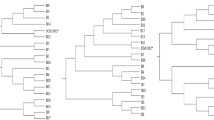Abstract
Based on inhibition of acid production, 100 individual colonies of Streptococcus thermophilus isolated from commercial Direct Vat Set yoghurt starter DVS-M were typed into 2 groups of sensitive and insensitive to phage φ001, which was isolated from the lysis culture of the turbidity test. The ratio between the sensitive and insensitive isolates in DVS-M was calculated at 3:2. Whole-cell protein profile (WCPP) and randomly amplified polymorphic DNA (RAPD) analysis showed that both WCPP and RAPD patterns between sensitive and insensitive isolates were distinct, whereas isolates with the same sensitivity or insensitivity shared common WCPP and RAPD patterns. It suggested that all the sensitive isolates belong to one S. thermophilus strain and all the insensitive isolates belong to another one. This study revealed that DVS-M yoghurt starter consists of 2 S. thermophilus strains with different phage sensitivity.
Similar content being viewed by others
References
Zhang X, Kong J, Qu Y. Isolation and characterization of a Lactobacillus fermentum temperate bacteriophage from Chinese yogurt. J. Appl. Microbiol. 101: 857–863 (2006)
Zhang HP. Present situation and development countermeasures for probiotic lactic bacteria and fermented milk in China. Dairy Sci. Technol. 2: 51–54 (2009)
Skriver A, Stenby E, Folkenberg D, Runge M, Bang Jensen N. Tools in the development of future starter cultures for fermented milk. pp. 55–61. In: Proceedings of the IDF Seminar on Aroma and Texture of Fermented Milk. Kolding, Denmark. International Dairy Federation, Brussels, Belgium (2003)
Liu H, Zhang XL. The isolation and identification of direct-to-vat yoghurt culture bacteria and study of composite fermentation quality. Food Sci. 23: 66–68 (2002)
Cong YT, Gao XJ, Liu YF, Qin J. Isolation and identification of lactic acid bacteria from EZAL-MY96. Biotechnology 14: 38–40 (2004)
Urshev ZL, Pashova-Baltova KN, Dimitrov ZP. Tracing Streptococcus thermophilus strains in three-component yoghurt starters. World J. Microbiol. Biot. 22: 1223–1228 (2006)
Baggesen DL, Wegener HC. Phage types of Salmonella enterica ssp. enterica serovar typhimurium isolated from production animals and humans in Denmark. Acta Vet. Scand. 35: 349–354 (1994)
Bannerman E, Boerlin P, Bille J. Typing of Listeria monocytogenes by monocin and phage receptors. Int. J. Food Microbiol. 31: 245–262 (1996)
Guglielmotti DM, Binetti AG, Reinheimer JA, Quiberoni A. Streptococcus thermophilus phage monitoring in a cheese factory: Phage characteristics and starter sensitivity. Int. Dairy J. 19: 476–480 (2009)
Lick S, Keller M, Bockelmann W, Jochem Heller K. Rapid identification of Streptococcus thermophilus by primer-specific PCR amplification based on its lacZ gene. Syst. Appl. Microbiol. 19: 74–77 (1996)
Svensson U, Christiansson A. Methods for phage monitoring. Bull. Int. Dairy Fed. 263: 29–39 (1991)
Quiberoni A, Tremblay D, Ackermann HW, Moineau S, Reinheimer JA. Diversity of Streptococcus thermophilus phages in a large-production cheese factory in Argentina. J. Dairy Sci. 89: 3791–3799 (2006)
Sanders ME, Klaenhammer TR. Characterization of phage-sensitive mutants from a phage-insensitive strain of Streptococcus lactis: Evidence for a plasmid determinant that prevents phage adsorption. Appl. Environ. Microb. 46: 1125–1133 (1983)
Guimont C, Clary D, Bracquart P. Analysis of whole-cell proteins of Streptococcus thermophilus by 2 electrophoretic methods. Lait 74: 13–21 (1994)
Sarmiento-Rubiano LA, Berger B, Moine D, Zúñiga M, Pérez-Martínez G, Yebra MJ. Characterization of a novel Lactobacillus species closely related to Lactobacillus johnsonii using a combination of molecular and comparative genomics methods. BMC Genomics 11: 504 (2010)
Bradford MM. A rapid and sensitive method for the quantitation of microgram quantities of protein utilizing the principle of protein-dye binding. Anal. Biochem. 72: 248–254 (1976)
Massa R, Bantar C, Lopardo H, Vay C, Gutkind G. Whole-cell protein profiles are useful for distinguishing enterococcal species recovered from clinical specimens. Rev. Argent. Microbiol. 39: 199–203 (2007)
Binetti AG, Suárez VB, Tailliez P, Reinheimer A. Characterization of spontaneous phage-resistant variants of Streptococcus thermophilus by randomly amplified polymorphic DNA analysis and identification of phage-resistance mechanisms. Int. Dairy J. 17: 1115–1122 (2007)
Samarzija D, Sikora S, Redzepoviæ S, Antunac N, Havranek J. Application of RAPD analysis for identification of Lactococcus lactis subsp. cremoris strains isolated from artisanal cultures. Microbiol. Res. 157: 13–17 (2002)
Sturino JM, Klaenhammer TR. Engineered bacteriophage defense systems in bioprocessing. Nat. Rev. Microbiol. 4: 395–404 (2006)
Barrangou R, Fremaux C, Boyaval P, Richards M, Deveau H, Moineau S, Romero DA, Horvath P. CRISPR provides acquired resistance against viruses in prokaryotes. Science 315: 1709–1712 (2007)
Deveau H, Barrangou R, Garneau JE, Labonté J, Fremaux C, Boyaval P, Romero DA, Horvath P, Moineau S. Phage response to CRISPR-encoded resistance in Streptococcus thermophilus. J. Bacteriol. 190: 1390–1400 (2008)
Ashmaig A, Hasan A, Gaali EE. Identification of lactic acid bacteria isolated from traditional Sudanese fermented camel’s milk (Gariss). Afr. J. Microbiol. Res. 3: 451–457 (2009)
Ghazi F, Henni DE, Benmechernene Z, Kihal M. Phenotypic and whole cell protein analysis by SDS-PAGE for identification of dominants lactic acid bacteria isolated from Algerian raw milk. World J. Dairy Food Sci. 4: 78–87 (2009)
Lazzi C, Bove CG, Sgarbi E, Gatti M, La Gioia F, Torriani S, Neviani E. Application of AFLP fingerprint analysis for studying the biodiversity of Streptococcus thermophilus. J. Microbiol. Meth. 79: 48–54 (2009)
Sánchez I, Seseña S, Palop L. Identification of lactic acid bacteria from spontaneous fermentation of ‘Almagro’ eggplants by SDSPAGE whole cell protein fingerprinting. Int. J. Food Microbiol. 82: 181–189 (2003)
Moineau S, Tremblay D, Labrie S. Phages of lactic acid bacteria: From genomics to industrial applications. ASM News 68: 388–393 (2002)
Author information
Authors and Affiliations
Corresponding author
Rights and permissions
About this article
Cite this article
Ma, C., Wu, Z., Chen, Z. et al. Differentiation of Streptococcus thermophilus strains in commercial Direct Vat Set yoghurt starter. Food Sci Biotechnol 22, 987–991 (2013). https://doi.org/10.1007/s10068-013-0174-x
Received:
Revised:
Accepted:
Published:
Issue Date:
DOI: https://doi.org/10.1007/s10068-013-0174-x




